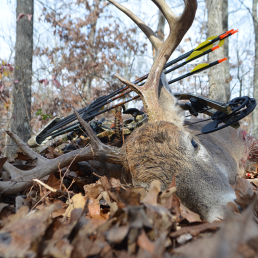Viewing October from a Bow Stand
SHARE THIS POST
October is perhaps the favorite month of bowhunters, but those October sits are not all about the deer.
The grip of fall weather has solidified by the early days of October. Mornings are cooling and fall scents waft on the breeze. Summer’s growing season is complete, and the sweet scent of decaying plant matter permeates the rising air currents. Perceptive bowhunters catch the fragrance high in their tree stands.
Savvy bowhunters notice and appreciate the palette of fall colors, for they know the advancing days bring better hunting opportunities.
Scarlets of Virginia creeper and crimson colors of sweet gum leaves are among the brightest of woodland colors. Hickories sport bright yellow leaves, as do black walnuts. The mottled reds and browns of dogwood leaves are accented by bright red berries, which serve as fall fruits for a host of woodland birds, including wild turkeys.
The grand oaks, upon which deer depend for an acorn crop, begin a show of color, as leaves and acorn shells become a mottling of browns and greens. Woodland asters show purple flowers with golden centers, while patches of golden rod begin to resemble nature’s golden arches.
Sassafras, known for its spicy roots, and reputation as the only known tree with three distinctively shaped leaves, begins a showy display of oranges and reds, as do persimmons. These pulpy fruits mature and become edible with the first frosts of October. The first frost will raise their sugar content. Deer, opossums, foxes, coyotes and a host of other forest creatures relish these sweet fruits. They don’t last long.
Bowhunting near a grove of persimmon trees often pays handsome rewards. I arrowed one of the best bucks of my life by shaking persimmons to the ground before climbing into my stand. Every persimmon on the ground had been consumed and the ground had been trampled to dust by feeding deer.
Are you enjoying this post?
You can be among the first to get the latest info on where to go, what to use and how to use it!
A nearby doe heard the familiar sound of persimmons hitting the ground and showed herself within five minutes. She constantly raised her head to look over her shoulder as she fed on the persimmons, a sure sign that a buck was near.
Ten minutes later, a fat, 8-point buck trotted to the small persimmon grove and began feeding excitedly. Persimmons are like deer candy and the greedy buck intended to get his share.
I’ll never forget the 35-yard shot at the regal buck under the persimmon trees in a magical place called Paradise Valley. My arrow met its mark. The tracking job proved very easy, and soon I ran my hands over the polished antlers and sleek hide of a true Ozarks Mountains buck.
I remember the meat from the buck being especially flavorful. I imagined that the taste had been derived from the buck eating so many sweet persimmons. Regardless, it made many tasty meals for me and my family over the winter.
For more insight and tips for hunting and fishing throughout the year, check out the articles in every issue of MidWest Outdoors, available by subscribing on our website.
MWO
SHARE THIS POST
You may also like...
Nothing found.
Did you enjoy this post?
You can be among the first to get the latest info on where to go, what to use and how to use it!
Bill Cooper
An inductee to the National Fresh Water Fishing Hall of Fame, Bill Cooper, from the Missouri Ozarks, has written over 4,000 articles on outdoor subjects. You can hear him on Wild at Heart Outdoor radio at espn1073.com.
